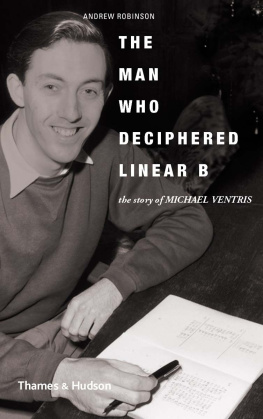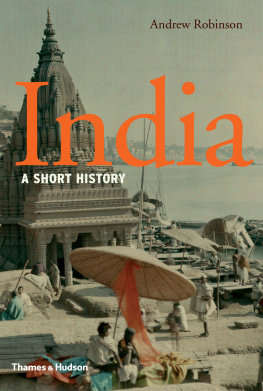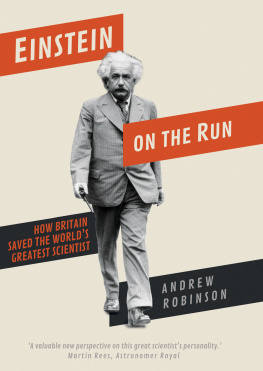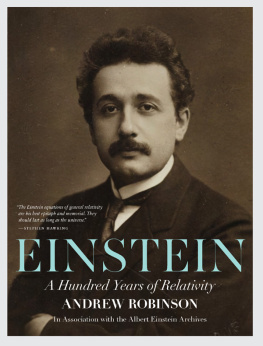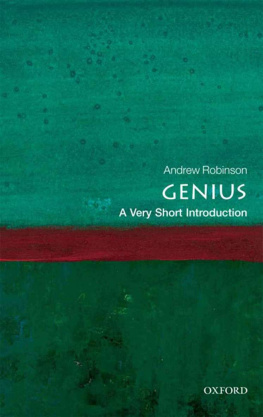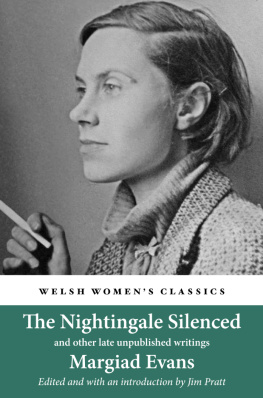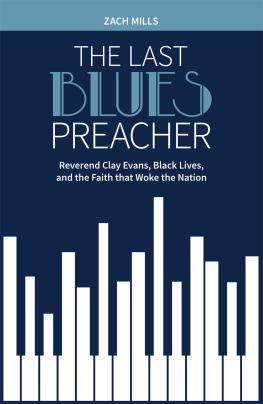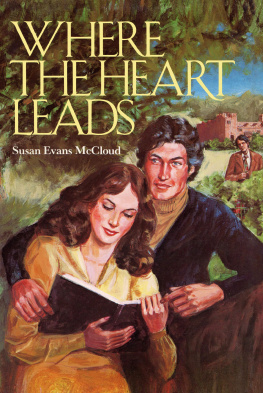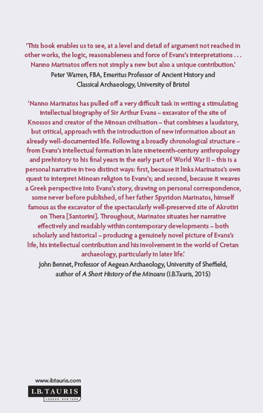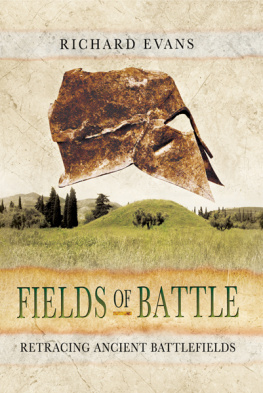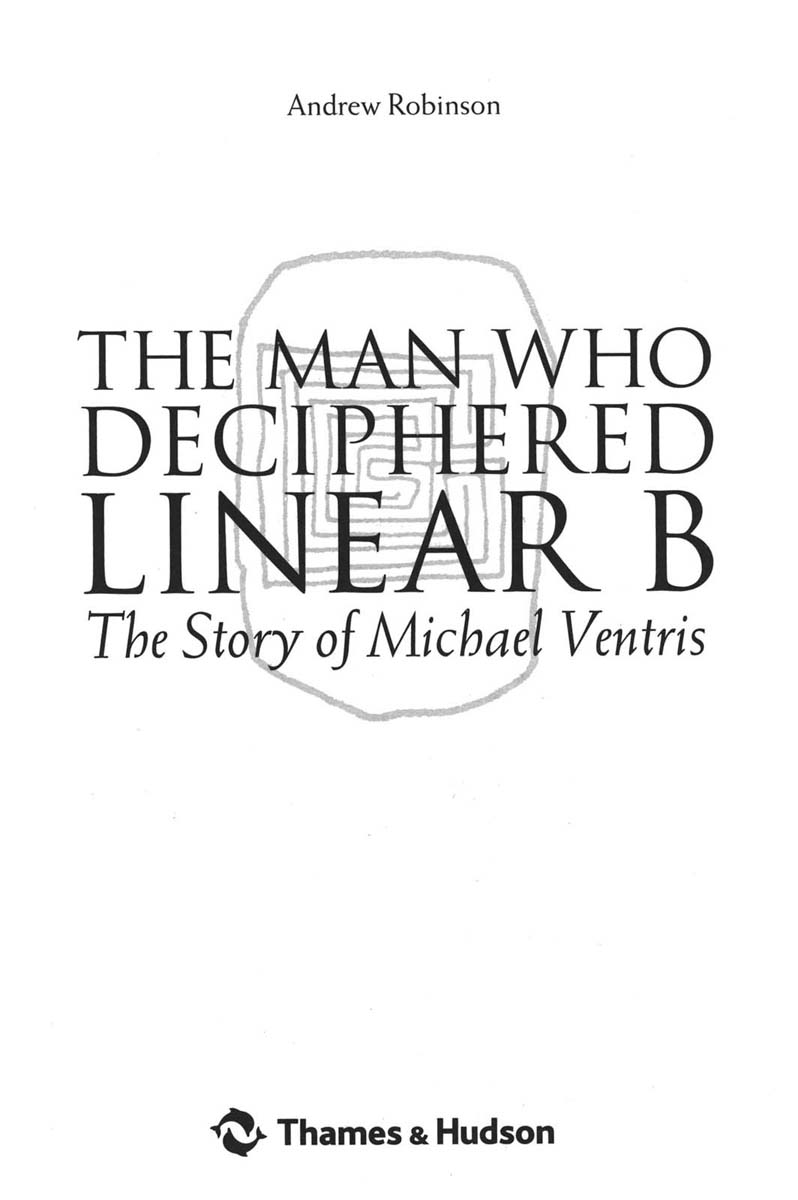
About the Author
Andrew Robinson is a Kings Scholar of Eton College, where he won the headmasters Greek grammar prize, and holds a degree from Oxford University; he was also a visiting fellow of Wolfson College, Cambridge.
His many books include The Story of Writing: Alphabets, Hieroglyphs and Pictograms and Lost Languages: The Enigma of the Worlds Undeciphered Scripts, and biographies of Thomas Young (The Last Man Who Knew Everything) and Jean-Franois Champollion (Cracking the Egyptian Code).
Other titles by Andrew Robinson published by Thames & Hudson include:
The Scientists: An Epic of Discovery
Reading Maya Art: A Hieroglyphic Guide to Ancient Maya Painting and Sculpture
The Story of Writing: Alphabets, Hieroglyphs and Pictograms
Cracking the Egyptian Code: The Revolutionary Life of Jean-Franois Champollion
Lost Languages: The Enigma of the Worlds Undeciphered Scripts
Other titles of interest published by Thames & Hudson include:
Minoan and Mycenaean Art
Breaking the Maya Code
See our websites
http://www.thamesandhudson.com
http://www.thamesandhudsonusa.com
To the memory of Antony Coulthard (191845), a gifted linguist and the Uncle I never knew
Acknowledgments
I first became interested in Michael Ventris in 1989, while researching a television programme about his decipherment of Linear B. Although the programme was not made, I found myself writing a few pages about the decipherment in my 1995 book, The Story of Writing, and becoming curious about the somewhat shadowy personality behind the achievement. I also became friendly with his collaborator John Chadwick, author of The Decipherment of Linear B, who helped me considerably until his death in 1998.
While writing this small book, which is obviously not a full biography, it has been pleasant to discover that Ventriss generosity and cooperative spirit live on nearly half a century after his death. I have enjoyed invaluable help from his surviving friends and from younger admirers of all that he achieved in his short life, in both decipherment and architecture.
In the world of classical studies, I am indebted to Alicia Totolos, former secretary of the Institute of Classical Studies in London, who went to great trouble to make available Ventriss letters and papers, including the press coverage of the decipherment; to John Killen, emeritus professor of Mycenaean Greek at Cambridge University, a close associate of John Chadwick, who put Chadwicks papers on the decipherment at my disposal; and to Tom Palaima, professor of classics at the University of Texas at Austin, who sent me copies of Ventriss letters to Emmett Bennett Jr and Alice Kober from his PASP archives. All three also shared with me their personal knowledge of the subject.
In the world of architecture, Oliver Cox, a close friend of Ventris as a student at the Architectural Association school, was constantly encouraging and put me in touch with architects and others who knew Ventris. These include Colin Boyne, Dargan Bullivant, Michael Grice, David Medd and Edward Samuel, to all of whom I am grateful, especially Colin Boyne, former editor of the Architects Journal, and Dargan Bullivant, both of whom provided essential background for understanding Ventriss final architectural project.
Among the Ventris family, I am grateful to his grandson Bjrn Ventris (son of the late Nikki Ventris) and Bjrns mother Renee Ventris, who showed me papers and photographs and discussed Ventrissfamilylife; to his daughter Tessa Ventris, who kindly granted permission to quote from Ventriss letters and writings; and to Carol Horton, half-sister of Lois Ventris.
Grateful thanks are also due to Dr John Bennet (of Oxford University) and Tony Meredith (of Stowe School) for essential help, and to Prof. Emmett Bennett Jr, Prof. Sir John Boardman, Jean Cox, Prof. Eric Handley, Rachel and Sinclair Hood, the late Patrick Hunter, Prof. Maurice Pope, Dr Tessa Rajak, John Renton, Robin Richards, Dr Sue Sherratt, Dr John Simopoulos and the late Prudence Smith.
Finally, I thank the staff of Thames & Hudson for the care and intelligence they have shown in producing the book. Jamie Camplin, my longstanding editor, deserves a personal mention, even though he has a Ventris-like reticence about being acknowledged. He is certainly among the best there is.
London, August 2001
Introduction
There is a land called Crete, set in the wine-dark sea, lovely and fertile and ocean-rounded. Those who live in this land are many, indeed past counting, and there are ninety cities there. The population speaks many tongues; there are Achaeans, there are the brave True Cretans, the Cydonians, the triply divided Dorians and the noble Pelasgians. Among the cities is mighty Knossos; its king was once Minos, who every ninth year took counsel with Zeus himself.
Odysseus in Homers Odyssey, Book XIX
A mere two hundred years ago, the worlds oldest known languages were Greek, Latin and Hebrew. History, in the sense of readable written records, began no earlier than about 600 B.C. Although the antiquity of inscriptions in Egypt and the Near East was suspected, nothing definite could be said about it, beyond what was written in those parts of the Old Testament that seemed historical, and in the confusing accounts of ancient historians and geographers such as Herodotus and Strabo. The age of civilization in India, China and the Americas was terra incognita.
But then, around 1805, a French schoolboy, Jean-Franois Champollion, seeing some of the treasures just brought back from Egypt by Napoleons savants, became determined to decipher the Egyptian hieroglyphs. Twenty years later, with the help of the Rosetta stone, Champollion succeeded and was able to read the script of the pharaohs; as a direct result, the historical time span was doubled, extending back to about 3000 B.C. Later in the 19th century, the cuneiform scripts of Mesopotamia were also deciphered; and scholars were able to understand a range of Near Eastern tongues and read the records and literature of ancient Sumer, Babylon and Assyria, comparable in age with those of Egypt.
Europe, however, still seemed to possess no civilization older than the glories of classical Greece unless one included the tantalizing stories of the Trojan war composed by Homer at an uncertain date and orally transmitted to later writers. Heinrich Schliemanns famous excavations at Troy and Mycenae in the 1870s, stimulated by his passion for Homer, put paid to that mistaken impression for ever. Here were golden treasures and a powerful citadel with a Lion Gate worthy of Homers King Agamemnon, belonging to a Bronze Age civilization dating to 14001200 B.C or earlier: clear evidence, thought some archaeologists (including Schliemann himself, to begin with), that the Mycenaeans were Greeks, ancestors of the founders of western civilization. But the experts in classical Greek art were unconvinced by the new finds which they thought generally barbaric, and the classical philologists were offered no Mycenaean inscriptions to decipher and learn the Mycenaean language from. For no writing had been found at Mycenae by a disappointed Schliemann: not even fragments, certainly no hoped-for record of the Trojan war. It appeared that the Mycenaeans were illiterate, and not Greek speakers, and that there was no continuity between the newly discovered civilization and the classical Greeks who wrote with an alphabet, the ancestor of our modern alphabets.
Next page
